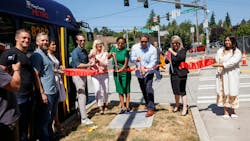SDOT, King County Metro add expanded 24/7 bus lanes along Aurora Ave North corridor
The Seattle Department of Transportation (SDOT), in partnership with King County Metro, completed major improvements along Aurora Avenue North. The improvements include adding expanded 24/7 bus lanes from downtown Seattle to North 145th St. SDOT says the all-day, bus-only lanes improve frequency and reliability on the RapidRide E Line for nearly 14,000 transit riders daily.
“These lanes will benefit thousands of people per day, including the 14,000 daily riders of the RapidRide E Line, [King County] Metro’s most popular route,” said King County Metro General Manager Michelle Allison. “A single bus lane can move far more people than a lane filled with cars. Bus lanes are simply a smart, low-cost way to deliver faster, fairer and greener transportation.”
SDOT notes the bus lanes take the city of Seattle closer to a bus system where a schedule isn’t needed, so riders can arrive at their bus stop and enjoy service every five to 15 minutes depending on the time of day.
Project highlights include:
- Over 600 new traffic and no parking signs installed.
- New red pavement markings added to designate bus-only areas south of the Aurora Bridge in the northbound direction to match the existing southbound bus-only lanes.
- People driving and making deliveries can use the bus-only lane to make right turns or reach local shops and services.
- On-street parking and loading shifted to side streets, with a few signed exceptions.
SDOT says refreshed curb paint at 28 bus zones between North 38th St. and North 115th St. is coming soon. The new Aurora Ave North corridor design is focused on improving safety, mobility and accessibility for everyone who uses the route. According to SDOT, the work will shape the long-term future of 24/7 bus lanes and guide other key improvements along the corridor. The department has recently upgraded several transit lines in Seattle thanks to voter-approved funding, including:
- Improvements along Route 44 and Route 48.
- Improvements to the RapidRide D Line on 15th Ave. NW between NW Market Street and the Ballard Bridge.
- Expansion of Rainier Ave S bus-only lanes to support Route 7, as well as pedestrian access and safety improvements.
- Installation of bus-only lanes at five locations along the Route 40 Line and future pilot of a freight and bus lane along Westlake Ave North.
- Completing the RapidRide G Line Project, which began service in 2024 and is averaging over 6,100 weekday boardings, making it one of the top 15 routes in the system.
SDOT notes the work comes alongside other initiatives made possible by the Seattle Transit Measure, including service investments to make buses come more frequently, distributing free ORCA cards to more than 10,000 Seattle Housing Authority residents and hosting field trips to familiarize seniors with their transit options.
According to SDOT, the work is coupled with Sound Transit’s Link light-rail expansion and other efforts to make using transit even easier and more accessible, including free bus trips for youth 18 and younger funded by the state.
“Aurora Avenue North is a critical corridor for Seattle and the addition of 24/7 bus-only lanes is a step toward a more connected and sustainable future,” said Seattle Mayor Bruce Harrell. “This initiative not only ensures easier, more reliable transit during this summer’s construction, but also reflects our broader commitment to accessible transit for all. This is just one of the many innovative steps we’re taking to improve transit, connect neighborhoods and build a stronger, more united Seattle.”
SDOT Interim Director Adiam Emery added, “Thanks to the voter-approved Seattle Transportation Levy and Seattle Transit Measure, we continue to make significant progress toward a more connected and equitable city through investments in our transit system. The round-the-clock, bus-only lanes on Aurora Avenue North represent an essential step forward for transit in Seattle, ensuring quicker, more dependable service for the nearly 14,000 daily riders of King County Metro’s RapidRide E Line. These improvements not only help people get where they need to go faster, but also support our broader goals of sustainability and accessibility as we create a future where every Seattle resident has access to reliable, low-cost transportation options.”
